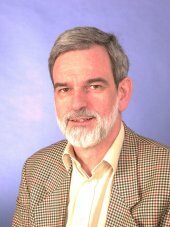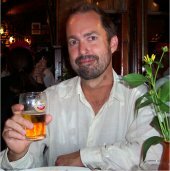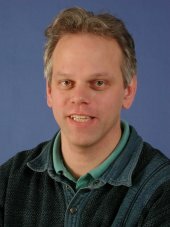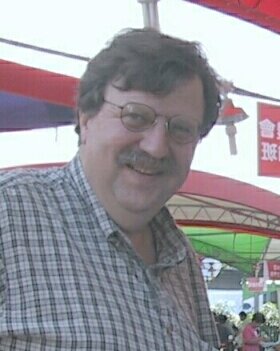 |
Section leader: Prof. Dr. Ir. C.A. Grimbergen
e-mail: [email protected]
Cornelis A. Grimbergen (Kees) was born in Leiden, the Netherlands, in 1947. After receiving his Ir. degree in Electrical Engineering at the Delft University of Technology he was active in research in solid-state physics, semiconductor technology, resulting in a Ph.D. degree in 1977 from the State University of Groningen. From 1977 he has been with the Laboratory of Medical Physics of the Faculty of Medicine of the University of Amsterdam working as an assistant-professor. From 1991 he is a part-time professor at the Measurement & Control Department of the Faculty of Mechanics of the Delft University of Technology. From 1995 he is also professor in Medical Technology at the Academic Medical Center of the University of Amsterdam (AMC).
Since 1996 he is heading the MTO, the medical-technological development department of the AMC, a development workshop with about twenty mechanical, ten electronical and two glass engineers. He is involved in committees determining the strategy of acquisition of instrumentation for the AMC and organizes annually a symposium on trends in medical technology.
His interests and research projects are in the fields of medical instrumentation, biomedical signal and image processing, and minimally-invasive techniques.
List of recent publications
Current research
|
 |
Dr. E. VanBavel (Associate Professor of Medical Physics)
e-mail: [email protected]
Ed van Bavel obtained his Masters Degree at the Leiden University in 1985 and received his Ph.D. Degree in 1989 in Amsterdam. Since then he has been working on micro vascular biomechanics and the control of microvascular tone and structure. Emphasis in this work is on the behavior of isolated arterioles in acute settings and in culture. Functional studies on these vessels are combined with calcium imaging and vascular biology. Remodeling is studied in vitro in cultured arterioles under pressure and flow. This work is extended with mathematical modeling and simulation techniques.
List of recent publications
Current research
|
 |
Dr. ir. G.J. Streekstra
e-mail:
Geert Streekstra was born in Kampen in 1961. He received his master degree in Technical Physics at the Twente University in Enschede in 1988. In the same year he started his Ph.D. research at the departments of Medical Physics and Haematology of the Utrecht University. In Utrecht he designed and implemented a rheoscope for the measurement of deformation and orientation of red blood cells in flow and developed a theoretical description of the light scattering by red blood cells in an Ektacytometer. In 1994 he received is Ph.D. degree and started as Post-doc at the University of Southern California California to investigate the utilization of the light scattering theory for measurement of red cell deformability in patients with Sickle Cell Disease.
In 1995 he started as a researcher at the dept. of Experimental Cardiology of the Utrecht University where he worked on the development of an automated grafting method for bypass surgery. From 1996-2000 he was Post Doc in the depts. of Intelligent Sensory Information Systems and Molecular Cytology at the University of Amsterdam. In Amsterdam the research activities were devoted to image analysis in 3D confocal microscope images in particular detection of threadlike structures and analysis of time sequences.
Since 2000 Geert Streekstra has been assistant professor at the department of Medical Physics. His current research interests are the analysis of 3D medical images from several imaging modalities and development of haemorheological instrumentation.
List of recent publications
Current research
|
 |
Dr. Henk Venema
e-mail: [email protected]
Henk W. Venema received the MS and PhD degree in Experimental Physics from the University of Amsterdam, Netherlands, in 1969 and 1982, respectively. He joined the Laboratory for Medical Physics, and in 1973 also the Radiology Department, both of the University of Amsterdam. His PhD research was on the analysis of the spatial distribution of fiber types in muscle cross sections using Markov Random Field models.
At present he works both at the Medical Physics Department and the Radiology department of the AMC. His current research interests are image processing and pattern recognition, and the physical and mathematical aspects of image formation with x-rays (both conventional and CT) and radiological protection.
List of recent publications
Current research
|
 |
Dr. ir. Maria Siebes
e-mail:
Maria Siebes received her engineering degree (Diplom-Ing.) in Technical Health Sciences from the University of Applied Sciences in Giessen, Germany, in 1981 and worked at the Max-Planck-Institute for Physiological and Clinical Research in Bad Nauheim, Germany, where she investigated the pressure-flow characteristics of arterial stenoses. With a Fulbright Scholarship she enrolled in 1983 at the University of Southern California, Los Angeles. During her studies, she was awarded two ZONTA Amelia Earhart Fellowships and worked on quantitative coronary angiogram analysis as a member of the Biomedical Image Processing Group at the Jet Propulsion Laboratory/CalTech in Pasadena. She received her M.S. (1984) and Ph.D. (1989) degree in Biomedical Engineering. Her PhD thesis is entitled “Modeling and Simulation of a Compliant Coronary Stenosis during the Cardiac Cycle”.
In 1989, she became Assistant Professor in the Dept. of Biomedical Engineering of the University of Iowa in Iowa City, IA, where she was active in teaching (Outstanding Teacher Award in 1992) and interdisciplinary research, supported by grants from the Whitaker Foundation, National Institutes of Health, and National Science Foundation. In 1996, she spent her sabbatical as Visiting Scientist at the Cardiovascular Research Institute of the University of Amsterdam and transferred in 1997 to the Dept. of Cardiology at the Academic Medical Center. Since 2002 she holds a tenured faculty position in the Dept. of Medical Physics at University of Amsterdam.
Dr. Siebes is Associate Editor of Medical and Biological Engineering & Computing and a member of several national and international professional societies in engineering and cardiology. She currently serves on the Council of the European Alliance for Medical and Biological Engineering and Science (EAMBES) and chairs the ‘Women in MBE’ Committee of the International Federation of Medical and Biological Engineering (IFMBE). Her research interests center on the coronary circulation in health and disease, with an emphasis on the assessment of the coronary microcirculation and functional stenosis severity from physiological measurements in man. Her work combines biofluid mechanics, medical imaging, physiology, and modeling of the coronary circulation.
List of recent publications
Current research
|


